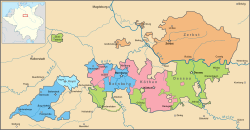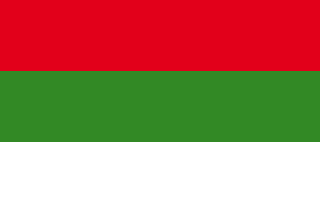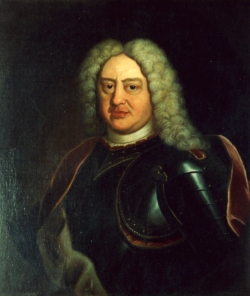Principality of Anhalt-Zerbst
Last updatedPrincipality of Anhalt-Zerbst | |||||||||||||
|---|---|---|---|---|---|---|---|---|---|---|---|---|---|
| 1252–1396 1544–1796 | |||||||||||||
 Anhalt principalities (1747-1793), Zerbst in orange | |||||||||||||
| Status | State of the Holy Roman Empire | ||||||||||||
| Capital | Zerbst | ||||||||||||
| Common languages | Upper Saxon | ||||||||||||
| Government | Principality | ||||||||||||
| Historical era | Middle Ages | ||||||||||||
• Partitioned from Anhalt | 1252 | ||||||||||||
1396 | |||||||||||||
• Partitioned from Anhalt-Dessau | 1544 | ||||||||||||
• Partitioned1 | 1603 | ||||||||||||
• Partitioned2 | 1667 | ||||||||||||
| 1796 | |||||||||||||
• Duchy of Anhalt reunited | 1863 | ||||||||||||
| |||||||||||||
1: In 1603, Anhalt-Zerbst lost territory to Anhalt-Dessau, Anhalt-Bernburg, Anhalt-Plötzkau and Anhalt-Köthen. 2: In 1667, Anhalt-Zerbst lost territory to create Anhalt-Mühlingen and Anhalt-Dornburg. | |||||||||||||
Anhalt-Zerbst was a principality of the Holy Roman Empire ruled by the House of Ascania, with its residence at Zerbst in present-day Saxony-Anhalt. It emerged as a subdivision of the Principality of Anhalt from 1252 until 1396, when it was divided into the principalities of Anhalt-Dessau and Anhalt-Köthen. Recreated in 1544, Anhalt-Zerbst finally was partitioned between Anhalt-Dessau, Anhalt-Köthen, and Anhalt-Bernburg in 1796 upon the extinction of the line.
Contents
History
It was created when the Anhalt territory was divided among the sons of Prince Henry I into the principalities of Anhalt-Aschersleben, Anhalt-Bernburg and Anhalt-Zerbst in 1252. In the course of the partition, Prince Siegfried I, the youngest son of Henry I, received the lands around Köthen, Dessau, and Zerbst. His son and successor Prince Albert I took his residence at Köthen Castle in 1295. In 1396, the surviving sons of Prince John II of Anhalt-Zerbst again divided their heritage: Sigismund I became Prince of Anhalt-Dessau and his younger brother Albert IV went on to rule as Prince of Anhalt-Köthen.

The principality was recreated, when in 1544 the heirs of Prince Ernest I of Anhalt-Dessau divided their territory and the eldest surviving son, Prince John V, took his residence at Zerbst Castle. The second incarnation, however, lost a lot of territory in 1603 when it was partitioned for a second time with some of its territory being given to Anhalt-Dessau, Anhalt-Bernburg, Anhalt-Plötzkau and Anhalt-Köthen.
By 1606, all Anhalt principalities had turned to the Reformed faith, however, Anhalt-Zerbst returned to Lutheranism in 1644. In 1667, Prince John VI inherited the remote Lordship of Jever in East Frisia. Upon his death in the same year, however, Anhalt-Zerbst lost more of its territory, with Anhalt-Mühlingen and Anhalt-Dornburg being created. The Jever lordship was administered by Ascanian relatives, it was hit hard by the Christmas Flood of 1717.
In 1742 princes John Louis II and Christian August of Anhalt-Zerbst-Dornburg inherited Anhalt-Zerbst. After Christian August's death in 1747, his widow Johanna Elisabeth of Holstein-Gottorp governed the country for her son Frederick Augustus until 1752. She had the new castle at Dornburg built as her thirds from 1750, a lavish baroque palace prepared to host her brother, Adolf Frederick, King of Sweden, or her daughter Sophie Auguste Fredericka, who in 1745 had married the Russian crown prince Peter III, to become empress in 1762, better known as Catherine the Great. However, neither of them ever visited her, and the dowager princess and her son were forced into exile when Prussian forces invaded Anhalt-Zerbst during the Seven Years' War in 1758. Frederick the Great, who had actually proposed the Russian marriage, accused the princess and her son of supporting Russia, then his war enemy. Johanna Elisabeth died in Paris in 1760 and her son, Frederick Augustus, never returned to Zerbst and continued to live in Basel and Luxemburg. Upon his death in 1793, the Principality of Anhalt-Zerbst came to an end with its territory being divided among the Ascanian princes of Anhalt-Dessau, Anhalt-Köthen, and Anhalt-Bernburg while Jever was inherited by his sister, Catherine the Great, and remained under Russian rule until 1818.
Princes of Anhalt-Zerbst

Princes, 1252–1396
- Siegfried I 1252–1298
- Albert I 1298–1316
- Albert II 1316–1362
- Albert III 1359 (co-regent)
- Waldemar I 1316–1368 (co-regent)
- Johann II 1362–1382
- Waldemar II 1368–1371 (co-regent)
- Waldemar III 1382–1391 (co-regent)
- Sigismund I 1382–1396 (co-regent)
- Albert IV 1382–1396 (co-regent)
Partitioned between Anhalt-Dessau and Anhalt-Köthen in 1396.
Princes, 1544–1796
- Johann V 1544–1551
- Karl I 1551–1561
- Bernhard VII 1551–1570 (co-regent)
- Joachim Ernest 1551–1586 (co-regent, later sole ruler; he unified all the Anhalt lands); later, his sons divided again Anhalt.
- Rudolph 1603–1621
- Johann VI 1621–1667
- Augustus of Anhalt-Plötzkau regent 1621–1642
- Karl William 1667–1718
- Sophie Auguste of Schleswig-Holstein-Gottorp regent 1667–1674
- Johann August 1718–1742
- Johann Ludwig II 1742–1746
- Christian Augustus 1742–1747 (co-regent)
- Friedrich August 1747–1793
- Joanna Elisabeth of Holstein-Gottorp regent 1747–1752
- Sophie Auguste Fredericke (Empress Catherine II of Russia) 1793–1796 (only in Jever)
To Anhalt-Dessau 1796.
See also
Related Research Articles
The House of Ascania was a dynasty of German rulers. It is also known as the House of Anhalt, which refers to its longest-held possession, Anhalt.

The Duchy of Anhalt was a historical German duchy. The duchy was located between the Harz Mountains in the west and the River Elbe and beyond to the Fläming Heath in the east. The territory was once ruled by the House of Ascania, and is now part of the federal state of Saxony-Anhalt.

The history of Saxony-Anhalt began with Old Saxony, which was conquered by Charlemagne in 804 and transformed into the Duchy of Saxony within the Carolingian Empire. Saxony went on to become one of the so-called stem duchies of the German Kingdom and subsequently the Holy Roman Empire which formed out of the eastern partition of the Carolingian Empire. The duchy grew to become a powerful state within the empire, ruling over much of what is now northern Germany, but following conflicts with the emperor it was partitioned into numerous minor states, including the Principality of Anhalt, around the end of the 12th century and early 13th century. The territories of the Duchy of Saxony, the Principality of Anhalt, and their successors are now part of the modern German state of Saxony-Anhalt.

Zerbst is a town in the district of Anhalt-Bitterfeld, in Saxony-Anhalt, Germany. Until an administrative reform in 2007, Zerbst was the capital of the former Anhalt-Zerbst district.

Anhalt-Dessau was a principality of the Holy Roman Empire and later a duchy of the German Confederation. Ruled by the House of Ascania, it was created in 1396 following the partition of the Principality of Anhalt-Zerbst, and finally merged into the re-united Duchy of Anhalt in 1863. The capital of the state was Dessau in present-day Saxony-Anhalt.

Anhalt-Köthen was a principality of the Holy Roman Empire ruled by the House of Ascania. It was created in 1396 when the Principality of Anhalt-Zerbst was partitioned between Anhalt-Dessau and Anhalt-Köthen. The first creation lasted until 1562, when it fell to Prince Joachim Ernest of Anhalt-Zerbst, who merged it into the reunited Principality of Anhalt.

Anhalt-Bernburg was a principality of the Holy Roman Empire and a duchy of the German Confederation ruled by the House of Ascania with its residence at Bernburg in present-day Saxony-Anhalt. It emerged as a subdivision from the Principality of Anhalt from 1252 until 1468, when it fell to the Ascanian principality of Anhalt-Dessau. Recreated in 1603, Anhalt-Bernburg finally merged into the re-unified Duchy of Anhalt upon the extinction of the line in 1863.

The Principality of Anhalt was a State of the Holy Roman Empire, located in Central Germany, in what is today part of the federal state of Saxony-Anhalt.
The Principality of Anhalt-Dornburg was located in what is today Germany. It was created in 1667 following the death of Prince John VI and the partition of Anhalt-Zerbst with Anhalt-Mühlingen being created along with Anhalt-Dornburg for the younger sons of Prince John VI. The principality lasted until 1742 when Princes Christian August and John Louis II inherited Anhalt-Zerbst.

Charles William, Prince of Anhalt-Zerbst, was a German prince of the House of Ascania and ruler of the Principality of Anhalt-Zerbst.
Albert I was a German prince of the House of Ascania and the second ruler of the Principality of Anhalt-Zerbst from 1298 until his death.
Waldemar III, Prince of Anhalt-Zerbst was a German prince of the House of Ascania and ruler of the principality of Anhalt-Zerbst.

Wolfgang, Prince of Anhalt-Köthen, was a German prince of the House of Ascania and ruler of the principality of Anhalt-Köthen. He was one of the earliest Protestant rulers in the Holy Roman Empire.
George I, Prince of Anhalt-Dessau, was a German prince of the House of Ascania and ruler of the principality of Anhalt-Dessau. He was the second son of Sigismund I, Prince of Anhalt-Dessau, by his wife Judith, daughter of Gebhard XI, Count of Querfurt.

John V of Anhalt-Zerbst, was a German prince of the House of Ascania and ruler of the principality of Anhalt-Dessau. From 1544, he assumed rule of the re-created principality of Anhalt-Zerbst.

Joachim Ernest of Anhalt, was a German prince of the House of Ascania, ruler of the principality of Anhalt-Zerbst from 1551, and from 1570 sole ruler of all the Anhalt lands.
John VI of Anhalt-Zerbst, was a German prince of the House of Ascania and ruler of the Principality of Anhalt-Zerbst.

Johann Ludwig II, Prince of Anhalt-Zerbst, was a German prince of the House of Ascania and ruler of the principality of Anhalt-Dornburg. After 1742 he became ruler over the principality of Anhalt-Zerbst.

Frederick Augustus, Prince of Anhalt-Zerbst, was a German prince of the House of Ascania and the last ruler of the Principality of Anhalt-Zerbst.

Sophie Augusta of Holstein-Gottorp was regent of Anhalt-Zerbst in during the minority of her son from 1667 until 1674.
References
Text is available under the CC BY-SA 4.0 license; additional terms may apply.
Images, videos and audio are available under their respective licenses.




